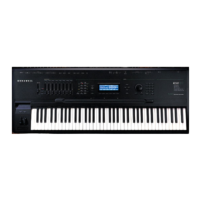Program Edit Mode
Arpeggiator Page
3-19
Editing Shift Patterns
You can edit the highlighted pattern by pressing the EDIT button. You can create a new user
pattern by editing an existing pattern and saving it to a user ID.
In the Shift Pattern editor, pressing the BANK - button removes the last step in the
list, pressing the BANK + button inserts a new note step at the end of the list. Use the
NAVIGATION buttons to move between pattern steps, use the ALPHA WHEEL or keypad
function of the CATEGORY buttons to enter the note shift amount for each step. You can
set a step to a value of “none” by selecting -127 and then scrolling down one more value. A
step with the value “none” causes the arpeggiator to play nothing for that step, allowing you
to create rhythmic patterns by using “none” to leave spaces.
Use the CHANNEL/PAGE buttons to change the direction in which pattern steps are played
(indicated by Up, Down, or Flat on the right of the top line). With pattern direction set to
Up, the pattern plays starting at step one and moving up through each step towards step 48.
With pattern direction set to Down, the pattern starts at step one, but then moves to the last
step and continues to move backwards through the steps down towards step 1 in the octave
below the rst note played. When the pattern direction is set to Up or Down, the pattern
will repeat transposed in the next higher or lower octave (limited by the Arpeggiator page
Shift Limit parameter). Patterns set to Flat play without transposition, in which case the
Shift Limit parameter can be used to restrict note range.
To save an edited pattern, press the front panel SAVE button to view the save dialog and
select a user ID. You can also rename the pattern if desired. Press the EXIT button to return
to the Arpeggiator page.

